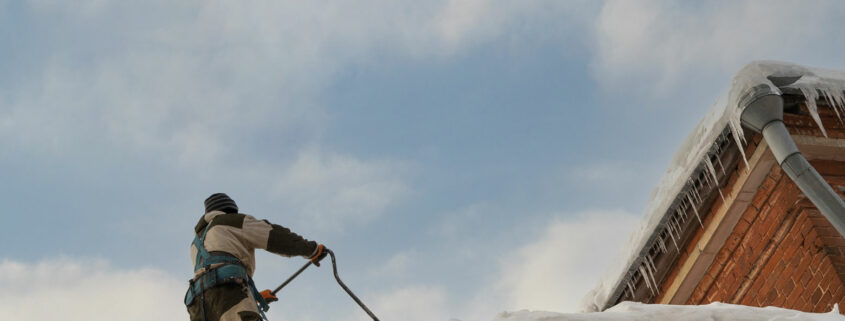As a business owner, you know the importance of taking care of your building. But how much of that focus is on winter commercial roof maintenance? With the winter months on their way, now is the time to make sure your commercial roof is ready for frigid temperatures, gusty winds, heavy snow, and melting ice. Winter weather conditions can be a recipe for roofing problems on any commercial roofing system.
To help guide you through essential winter season maintenance, learn some crucial tips and preventative maintenance so that your commercial roof remains in good condition.
Scope Out Your Drainage Systems
Throughout the year, especially in the autumn months right before winter, keeping roof drains on your commercial roof free of debris is crucial.
Check gutters, downspouts, and scuppers for clogs for a buildup of leaves, dirt, twigs, and other debris. As the temperatures fluctuate leading up to winter, ice buildup can also form, creating havoc on your roof drainage systems.
Blocked roof drains, especially on flat roofs, can lead to water ponding. This water weight increases the load that your commercial roof has to support, in turn causing structural damage and roof leaks. Trapped water can also freeze, leading to ice dams.
In addition to keeping an eye on your commercial building’s drainage systems, regular inspections from a professional roofing company help identify these issues before they require extensive roof repair.
Trim Overhanging Trees
Tree branches fall during extreme wind, and depending on your commercial roof membrane, there will be punctures that let water seep in, causing water damage to your roof material.
Trimming overhanging trees around a commercial building before winter is crucial in proactive property maintenance. As the colder months approach, the risk of severe weather events, including snow and ice accumulation, rises significantly. Overhanging tree branches can pose a serious threat to the structural integrity of the building during winter storms.
Heavy snow or ice can weigh down branches, causing them to break and potentially damage the roof, skylights, windows, or other parts of the structure. Trimmed trees reduce the likelihood of branches snapping under the weight of accumulated ice, preventing potential hazards to pedestrians and parked vehicles (and, of course, preventing commercial roof repair).
By addressing this potential risk before winter sets in, property owners not only protect their buildings from damage but also contribute to the safety and well-being of the surrounding environment.
Seal Cracks Before Regular Rain and Snowfall
Small openings like a crack in your commercial roof membrane can grow into a big problem.
Water infiltration can lead to extensive damage. Cold temperatures, combined with moisture, can result in cracks expanding, which exacerbate the problem.
Proactively sealing cracks saves you the headache of losing heat and extensive water damage. Look for cracks throughout your roof membrane, but also look at any flashings as well as around your HVAC system.
Staying on top of cracks extends the lifespan of your roof, reducing the need for a commercial roof replacement down the road (or even in the winter months when it’s cold and dangerous for commercial roofers).
Schedule Your Pre-Winter Roof Inspection
You should have a commercial roof inspection twice a year: one in the spring before severe summer weather and another in the fall before winter weather conditions.
Conducting a pre-winter commercial roof inspection helps you identify and address issues or existing roof damage you may not have known to look for. This includes not only cracks in the roof surface but weak spots in the roof as well.
Once the inspection is complete, you can make necessary repairs to ensure your commercial roof will remain in good condition through the winter.
Cover Your Roof With Your Warranty
Your roof has a warranty if it was installed by a commercial roofing contractor. Part of the warranty covers you from paying high costs on necessary repairs, but it also likely requires regular inspections throughout the year. Keep your warranty intact and get your inspections completed!
Plan for Snow Removal
There are telltale signs that you may have a failing commercial roof. You may not be able to spot those signs until a heavy snowfall — and then it’s too late.
Removing excessive snow from your commercial roof is crucial to alleviate ponding from melting snow. When water has no place to go, it expands and causes cracks, leading to roof leaks during freeze-thaw cycles.
Protect Your Roof for Winter With TEMA
Being proactive with winter commercial roof maintenance is a great line of defense against harsh winter conditions. It can feel like a lot of work to get your commercial building ready for winter, but TEMA Roofing Services can help streamline the process.
If you have questions or concerns regarding your commercial roof, give us a call. As roofing professionals with over 50 years of experience, we can handle all your roof needs!





